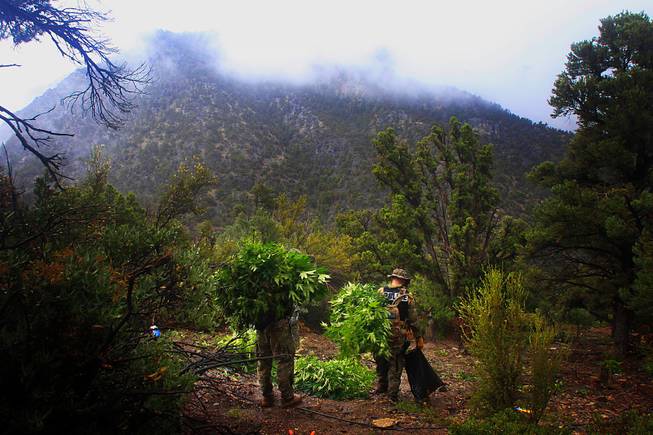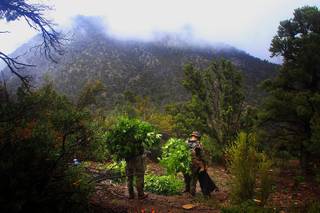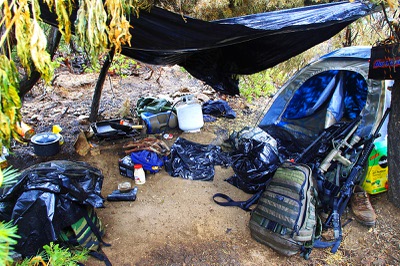
Law enforcement officers remove some of the 1,075 marijuana plants they seized at a grow site in the Carpenter Canyon area of the Spring Mountains on Wednesday, Sept. 14, 2011.
Thursday, Sept. 15, 2011 | 1:55 a.m.
Police bust marijuana farm
KSNV coverage of police raid in the Carpenter Canyon area of the Spring Mountains, where more than 1,000 marijuana plants were destroyed, Sept. 14, 2011.
Carpenter Canyon
Sun coverage
As a law enforcement team assembled Wednesday morning, two men guarding a marijuana farm rested at a makeshift mountainside camp.
The men had a kitchen stocked with food, a small stove and a pellet gun. And for when they could relax, two tents — filled with backpacks, shirts, jeans, high-top sneakers, sleeping bags, 9-mm ammunition and a crumpled Budweiser can — provided a retreat of sorts.
The camouflaged dwellings sheltered them from the elements and, until Wednesday morning, kept them hidden from authorities.
That’s when a multi-jurisdictional squad trekked 10 miles over the rugged terrain to the marijuana grow site on the west side of the Spring Mountains, near Mount Charleston.
It was the latest in a string of raids to dismantle outdoor marijuana grow operations, many on public land, that have popped up in Southern Nevada this year.
“They’re here to stay,” Metro Police Sgt. Erik Lloyd said of the outdoor grows. “This is just the start.”
In this case, the suspects, described as young men, fled on foot up the mountain in the Carpenter Canyon area as two raid teams approached from opposite directions.
Officers chased them on foot — at one point coming within 40 yards of one of the men — while a helicopter followed overhead. But authorities called off the chase when low-lying clouds unleashed a sudden downpour, rendering the mission unsafe.
“The suspects may have thought we were going up there to camp, so that might be why he didn’t spook until we saw him,” said Lloyd, a member of a multi-jurisdictional task force charged with eradicating outdoor marijuana grow sites.
Authorities say it’s difficult to capture those tending the grow sites because they can hear people approaching and typically have predetermined hideouts.
The suspect who lingered longer in the encampment Wednesday ran about 1.5 miles up the mountain before disappearing.
Authorities climbed an approximately 100-yard embankment to reach a clearing where 1,075 marijuana plants, estimated to be worth more than $5 million, were growing. Several hours later, nothing remained.
The team hacked off the plants as close to the ground as possible, tied them into 75-pound bundles and carted them off the mountain, destined for burial at an undisclosed location.
The operation dubbed “24D” — a common name for an herbicide — was the culmination of two months of planning. In July, a Metro search and rescue team spotted the marijuana plants while conducting an unrelated operation.
The growers’ ability to generate large marijuana crops for eventual sale isn’t the only thing that irks law enforcement officials. It’s also the environmental damage the operations cause.
Casey McEnry, a special agent for the Drug Enforcement Administration in California, said about 70 percent of outdoor grows busted in California are on public land, often involving elaborate water diversion systems from natural springs or creeks.
“Not only does diversion affect the wildlife in the area, they also use pesticides and fertilizers to keep animals away from plants,” she said, adding that officials also find trash and sometimes evidence of animal poaching.
The grow site at Carpenter Canyon, 7,200 feet up the mountain, was no exception.
The growers ran irrigation tubes, spray-painted black to make them harder to spot, from a natural spring at the top of the mountain to two man-made reservoirs about four feet deep.
From there, more tubes carried the water among the marijuana plants, which require about 1.5 gallons of water a day, authorities said. They also arranged nearby brush and tree limbs to support a tarp covering a processing station to dry the marijuana buds.
Compared to indoor, hydroponic grow houses, Lloyd said, outdoor grows are cheap. The drug-trafficking organizations’ biggest expense often is paying guards, many who are armed, to protect the site.
“They are usually given a sum of money at the beginning, some food and maybe a weapon,” McEnry said. “There’s often the promise of a large sum of money at the end of grow season.”
The marijuana grow season begins as early as March and can last through October, Lloyd said.
A year ago, Southern Nevada law enforcement officials doubted outdoor grows would make their way here, mostly because of the region’s rugged terrain. But growers, who have been operating heavily in California for many years, had other ideas.
Southern Nevada’s multi-jurisdictional task force has dismantled three outdoor marijuana grows in Lincoln County this summer, in addition to the raid on a Mount Charleston site in August that yielded 4,685 plants, Lloyd said.
In comparison, authorities seized more than 7 million marijuana plants at 1,481 outdoor grow sites in California last year, according to a DEA report from its Domestic Cannabis Eradication/Suppression Program.
Southern Nevada task force members recently trained in Sacramento with the California Bureau of Narcotics Enforcement’s CAMP (Campaign Against Marijuana Planting) program. Wednesday’s operation involved more people than normal because it served as additional training for members outside the U.S. Forest Service, which was the lead agency, Lloyd said.
Other participating agencies included Metro, the North Las Vegas Police Department, the DEA, Nye County Sheriff’s Office and the Nevada Department of Wildlife.
Authorities believe they’ll find more outdoor grow sites through their own investigations and tips from members of the public, such as hikers, Lloyd said.
“It’s something totally different that we haven’t had much experience on until now,” he said.



Join the Discussion:
Check this out for a full explanation of our conversion to the LiveFyre commenting system and instructions on how to sign up for an account.
Full comments policy